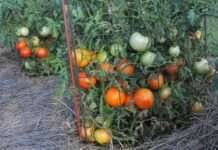By: Scott Eckert, County Extension Agent, Horticulture
I grew up in the sand hills a little bit West of here where the soil is SANDY. In sand you can dig by had all day long. Sand has its good points in that water drains or permeates well after heavy rains so plants don?t sit in excess water very long. The only thing we did to improve sand was add organic matter to actually help hold moisture longer and add nutrients.
Now I live in Newton and learned many years ago that this clay soil is vastly different than sand. Besides the fact that clay soil holds moisture it can also make tilling and growing vegetable plants difficult because it is heavy, tight and so hard to work. I recommend adding lots of organic matter (leaves, compost, manure, peat moss, etc.) to help make
this soil easier to work with. Another gardening practice I recommend is using raised beds.
Advantages of raised-bed gardening.
Better drainage – Growing plants in raised beds is a logical choice for gardeners with
heavy, poorly drained soils. Raised beds permit plant roots to develop in soil held above water-logged or compacted zones. This soil environment is much better for root growth. As beds are built up, compost or other forms of organic matter may be incorporated, further improving soil structure, drainage and nutrient-holding capacity.
Higher yields – Better root growth from improved soils leads to higher yields for food crops and lusher growth of ornamental plantings. Also, intensive planting in raised beds means more plants can be grown in a smaller area than with conventional row-cropping techniques. No space is wasted between rows.
Expanded growing season – Better drainage speeds soil warming and allows earlier spring planting. In wet seasons, soil dries faster, so planting can proceed between rains.
Easy maintenance – Because plants grow above the level of walkways, less stooping is required for weeding, watering and other chores. Intensively planted raised beds provide dense foliage cover, shading out much weed growth.
Using difficult sites – Raised beds make gardening possible on sites where growing plants would otherwise be impossible. Rooftop gardens and raised beds on top of solid rock are
examples. Terraced raised beds turn hillsides into productive growing areas while reducing soil erosion potential.
Types of raised beds
Temporary raised beds work well for many backyard vegetable gardeners. As the soil is tilled, it is loosened. If tillage equipment and foot traffic are kept off tilled beds, the loosened soil remains slightly raised above surrounding pathways. Adding compost or other organic matter to the bed raises it even higher.
The main advantage of temporary raised beds is their simplicity. No expense is involved in
constructing framework to contain the soil. Temporary beds are less labor intensive to make than permanent beds. However, temporary beds flatten over the course of a growing season and require reconstruction the next year. Also, because a temporary bed has no wall, the soil may erode from the top of the bed into walkways or down hillsides.
Permanent raised beds are more satisfactory for most situations. In the landscape, planting
berms may be constructed by hauling in topsoil to create traffic barriers as well as visual interest. When planted and mulched, berms need no edging to keep the soil in place. Walled raised beds may be used in the landscape or for vegetable gardens. Besides controlling erosion better than temporary beds, walled beds permit deep soil amendment.
Although constructing walls for raised beds takes labor and has an initial cost, the finished product should last for many years.




